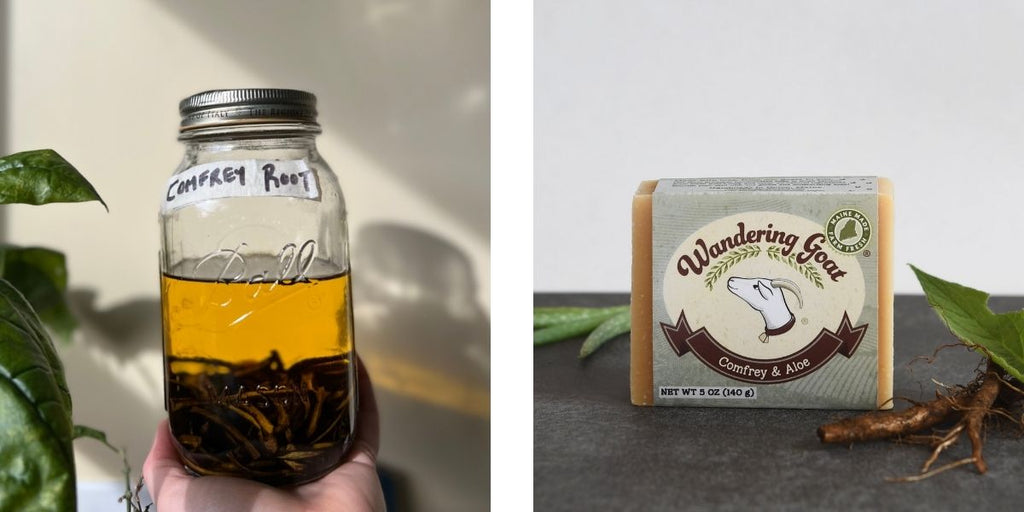Creating Infused Oils with Dried Herbs

We love to include infused herbal oils in our goat milks soaps and grow many of the herbs and flowers right here in our gardens. We select specific plants for their beneficial properties for the skin as well as for color, exfoliation, or simply to make a beautiful bar of soap. Throughout the summer, we gather the blooms from the garden to dry for making oil infusions and and we source dried organic plant material for those herbs and spices we can't grow here in Maine.
The art of infusing herbs and spices in oil dates back to the Egyptians- most notably frankincense and myrrh. They are also thought to have been the first to create aromatic medicine and the foundation of modern aromatherapy.
Infused herbal oils can be used in making your own lotions, lip balms, salves and can also be used as a delicious and healthy dressing for salads.
Note: Some herbs are for topical use only, so make sure that you research the plant before using it on a salad or in cooking.
Dried Herbs for Infusing in Oil
There are many plants that can be used in an infusion, either for their medicinal properties or simply for flavor. This list is an example of the most popular ones to try.
Basil
Garlic
Oregano
Rose Petals
Rosemary
Peppermint
Sage
Spearmint
* topical use only, not to be ingested
Great Base Oils for Making an Infusion
There are many beautiful oils out there, but when making soap, we stick to three oils: Coconut Oil, Olive Oil, and Jojoba Oil. Knowing that quality is key, we always work with organic oils because we want the best for our skin. In addition to their nourishing properties for the skin and scalp, these oils can be gently heated without concern for oxidizing, going rancid, or deteriorating in quality.
Coconut Oil
Coconut oil is great for incorporating into soaps and shampoo bars as it can increase the shine and deeply nourish healthy skin better than other oils. Coconut oil also has beneficial emollient properties that can protect the skin against environmental stressors. One thing to take into consideration is some people with sensitivities to nuts may be sensitive to using products with coconut oil. If you are unsure whether coconut oil will work on your skin, do a small oil test on your wrist before making your infusion.
Olive Oil
Olive oil is the ideal oil for all skin types. When applied to the skin or used in soaps, shampoos, and lotions, olive oil helps create a lightweight and neutral moisturizer. This makes it ideal for infusing fresh or dried herbs. Olive oil contains several antioxidants, compounds, and vitamins, particularly Vitamin E, which helps to maintain healthy skin.
Another reason we love using organic olive oil is that is non-toxic, anti-microbial and hypoallergenic.
Jojoba Oil
The lovely golden hue of jojoba is reason enough to use it on your skin. We source our jojoba oil from HobaCare, a wonderful local Maine business. Their beautiful oil is almost immediately absorbed into the skin, is lighter than olive oil or coconut, and has virtually no scent. It should also be noted that jojoba oil is for external use only.
Making the Infused Oil
Using a clean crockpot, place the setting to a low, or if you have one, a warm setting. The slow heat of the crockpot allows the base oil to slowly and thoroughly extract all the essential oils of the plant material. Measure out 2 cups of your chosen base oil and add to a blender. Then, add 1- 1.5 cups of your dried plant material. Generally, we use 1.5 cups for delicate dried flowers, like chamomile, calendula, or rose. For more resinous plants like lavender and rosemary, generally, 1 cup is perfect.
Pour the blended mixture into the crockpot and repeat (depending on how much oil you wish to make). Heat the oil for 8 to 24 hours after leaving the lid off the crockpot. Be sure to check and stir periodically to push the dried herbs down under the oil.

Another popular way to infuse oils is by using the warmth from natural sunlight. In this method, the herb and oil mixture is poured into a large glass jar and placed in a windowsill. You can blend the herbs and oils the same as above, or you can fill your jar with dried herbs and then pour the oils over the herbs until the oil is at least 1" above the plant material. Shake the mixture daily and make sure that the plant material is below the level of the oil. Leave the jar of oil to infuse for about 2 weeks.
After the oil has been infused, strain the mixture by pouring the oil through a clean cheesecloth into a clean glass container. You may do a second strain through a fine mesh sieve, depending on the herbs used. Any remaining plant material is not detrimental to the oil but may be cosmetically displeasing for some.
How long will my infused oil last?
When kept in a cool dark place, like a pantry or closet, your oil will remain fresh and viable for 12 months.
Creating infused oils is a fun and fantastic way to share your garden's bounty with friends and family. Who doesn't love a beautiful infused bottle of olive oil as a gift? As for us, incorporating herbal-infused oils is one way we guarantee the quality of our product and share our Maine garden with you in every bar of soap we make.




